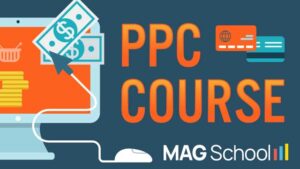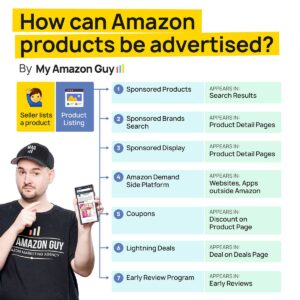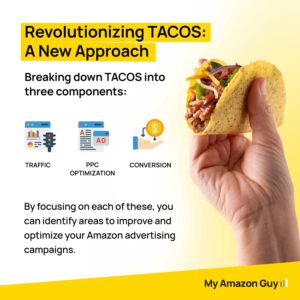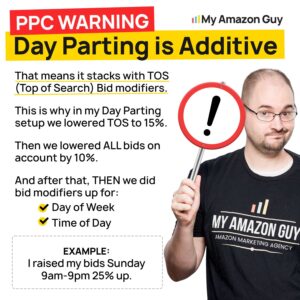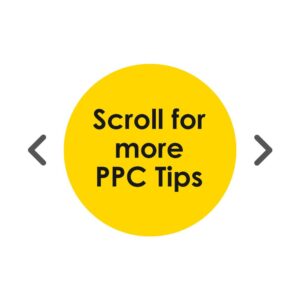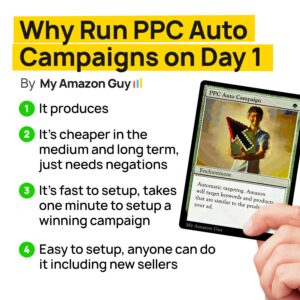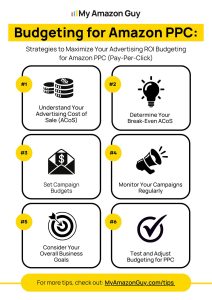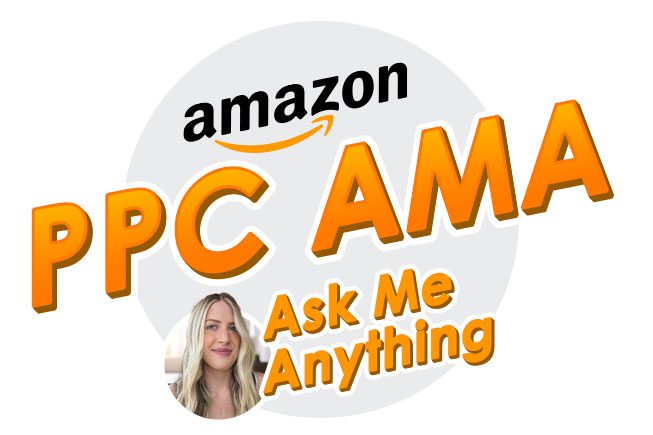Turn clicks to cash with Amazon PPC
Learn the Amazon PPC tactics our Amazon agency uses daily. This masterclass shows you how to fix budgets, nail keywords, and drive maximum ad performance.

Take the MAG School PPC Course
Learn how to structure, monitor, and optimize your paid advertising to maximize growth and profitability. Enroll Now
What is Amazon PPC?
Amazon PPC is the fuel that drives visibility and sales on the platform. It’s a pay-to-play system where sellers bid on keywords to get their products in front of shoppers.
Done right, it boosts rankings, increases conversions, and maximizes profits. Done wrong, it drains your budget fast.
Mastering Amazon PPC isn’t just about running ads—it’s about outsmarting the competition with data-driven strategies, tight budget control, and precise keyword targeting. If you’re not optimizing, you’re wasting money.
Types of Amazon PPC Ads
Sponsored Products
The most popular ad type, these appear in search results and product pages. They help individual listings gain traction, making them essential for product launches and ongoing sales.
Sponsored Brands
These ads showcase multiple products and your brand logo at the top of search results. Ideal for building brand awareness and driving traffic to your Amazon Store.
Sponsored Display
These retarget shoppers both on and off Amazon, reminding them about your product even after they leave the platform. Great for increasing conversions and brand recall.
Key Amazon PPC metrics to track
When managing Amazon PPC campaigns, tracking the right metrics is essential for understanding your campaign’s performance and making adjustments.
- Revenue & Ad Revenue
Always monitor your total sales and how much of it comes from PPC to gauge performance.
- ACoS & TACoS
ACoS (Ad Cost of Sales) tells you how much you’re spending on ads relative to PPC sales, while TACoS (Total Advertising Cost of Sales) puts it in the context of total revenue.
- Sessions & Click-Through Rate (CTR)
More sessions mean more traffic, but a low CTR signals weak ad performance or poor main images.
- Conversion Rate (CVR)
High traffic but low conversions? You might have a pricing problem, weak listing content, or irrelevant targeting.
- Impressions & Market Share
Use Amazon’s Search Query Performance Report to see how often your brand appears and how it compares to competitors.
If your conversion rate is dropping, cart adds aren’t leading to purchases, or your TACoS is creeping up, it’s time to adjust your PPC strategy. Stay on top of these metrics to maximize your ad efficiency and profitability.
Ready to supercharge your Amazon PPC strategy?
Get exclusive infographics that will elevate your PPC game, reduce ACoS, and drive more sales. Our free PPC Toolkit is packed with proven, actionable strategies designed to optimize your campaigns and maximize your results.
Fill out the form below, and we’ll send these valuable resources straight to your inbox free of charge!

Low vs High ACoS? Which is better?
A lower ACoS (Advertising Cost of Sale) is generally better in Amazon PPC. It means you’re spending less on ads relative to the sales you’re generating, indicating more efficient advertising.
However, if your ACoS is too low, you might be under-spending and missing out on potential sales. Aim for a balanced ACoS that aligns with your profit margins and overall business goals.
Low ACoS
- Indicates you’re spending less on ads relative to the sales generated.
- More efficient advertising, higher profitability.
- Can suggest you’re under-spending on ads, possibly missing out on growth opportunities.
High ACoS:
- Means you’re spending more on ads for each sale, which reduces profitability.
- Can indicate a need for better ad targeting or optimization.
- Acceptable for brand awareness or growth but must be monitored to avoid wasted ad spend.
Amazon PPC tips to lower ACoS
Lowering your ACOS involves a multi-faceted approach that combines strategic planning with continuous optimization:
- Keyword Research
Use robust tools to find highly relevant keywords that match your product and audience intent. Focusing on long-tail keywords can reduce competition and cost.
- Bid Optimization
Regularly adjust your bids based on performance. Lower bids on underperforming keywords and invest more in high-converting terms.
- Ad Copy
Craft compelling, clear ad copy that resonates with your target audience. An engaging ad can lead to higher click-through rates and better conversion rates.
- Campaign Structure
Organize your campaigns by product category or performance metrics. This allows for more granular control and easier optimization.
- Performance Monitoring
Continuously monitor campaign performance and adjust your strategy based on data insights. Incorporate A/B testing to determine which adjustments yield the best results.
Take control of your Amazon PPC costs today—watch this playlist below for actionable strategies to lower ACoS and maximize your ROI.
Playlist
Growing Sales with Amazon PPC
A well-optimized PPC campaign can do more than just lower ACOS—it can significantly boost your overall sales:
Targeting Different Customer Journey Stages
- Awareness: Use Sponsored Brands to introduce your brand to potential new customers.
- Consideration: Leverage Sponsored Products to capture interest from shoppers already searching for products like yours.
- Decision: Deploy Sponsored Display ads for retargeting, helping customers finalize their purchase decisions.
Channel Integration
Integrate your PPC efforts with other marketing channels such as social media, email campaigns, and content marketing. This holistic approach reinforces your brand message and drives more traffic to your listings.
Avoiding common Amazon PPC mistakes
While striving to optimize your Amazon PPC, steer clear of these common pitfalls:
- Overbidding
Excessively high bids can quickly drain your budget without yielding proportional sales.
- Neglecting Negative Keywords
Failing to add negative keywords can result in irrelevant clicks that inflate your ACOS.
- Ignoring Data
Not regularly reviewing performance data may lead you to miss out on opportunities for optimization or allow inefficiencies to persist.
- Poor Campaign Structure
A disorganized campaign can make it difficult to pinpoint issues or apply targeted improvements.
Avoid costly Amazon PPC errors—watch our playlist to identify common mistakes and master strategies for better ad performance!
Playlist
PPC Frequently Asked Question
How do I improve my PPC ads?
To improve PPC ads as an Amazon expert, one should focus on several key areas. Firstly, it is important to ensure that the ad copy is compelling and relevant to the product being advertised. This involves highlighting the product’s unique features and benefits and using strong calls to action to encourage clicks. Additionally, incorporating positive customer reviews and using high-quality product images can increase credibility and persuade potential customers to click on the ad.
Another crucial factor in improving PPC ads is targeting the right audience. Utilizing Amazon’s targeting options, such as keywords, product categories, and customer behavior, can ensure that the ad is reaching the right people. Bid optimization is also crucial for achieving a high return on investment (ROI), and should be continuously monitored and adjusted as needed. Finally, regularly monitor campaign performance and experiment with different strategies, such as different ad formats and bidding strategies.
5 Amazon PPC Hacks
Steven Pope discusses five Amazon PPC Hacks that you can do in under 5 minutes to help improve the performance of your ads.

Improve Search Rankings
Increase Conversion Rate
Tell Your Brand Story
Showcase Multiple Products
Missed our Amazon PPC AMA live stream?
Don’t worry—now’s your chance to access the full playlist and supercharge your Amazon advertising game! This exclusive video series dives deep into essential Amazon PPC strategies, providing expert advice on lowering ACoS/TACoS, mastering keyword targeting, and scaling your campaigns for maximum ROI.
Whether you’re looking to troubleshoot existing challenges or refine your ad tactics, our AMA sessions deliver actionable insights you can apply to your Amazon FBA business right away. Packed with real-time advice and pro-level tips, this is more than just a playlist—it’s your toolkit for driving success.
Watch the series now on and take the next step toward optimizing your Amazon PPC performance!
PPC Frequently Asked Question
What is a good CTR in Amazon PPC?
As an Amazon expert, what constitutes a good click-through rate (CTR) can vary depending on several factors such as product category, competition, and bidding strategy. Generally, a CTR of around 0.5% to 1% can be considered good on Amazon.
However, it is important to note that CTR should not be the sole metric for measuring the success of a PPC campaign, as conversion rates and return on ad spend (ROAS) are equally important. It is also important to continuously monitor and optimize campaigns to improve performance over time, and to make data-driven decisions based on campaign metrics. Advertisers should strive to achieve a balance between clicks and conversions, ensuring that their ads are generating quality traffic and ultimately driving sales. Ultimately, what constitutes a good CTR on Amazon depends on the specific goals and objectives of the campaign and the competitive landscape in which it is operating.
$87 Spend $1000 Monthly Revenue with PPC Hack, Coaching Testimonial of My Amazon Guy

What they say about us
Here’s what our customers have to say.

Amazon Accredited Advertising

PickFu Certified

Helium 10 Trusted Partner

“Hi Steven! Big fan of all the PPC/AMazon content that you put out”
~ Luke Basha
“Thank you all SO much for your desire to get this completed to levels beyond our satisfaction. It’s so impressive to me that you all, including the designer, didn’t stop until it was right.”
~ Patrick Shannon
Sprinkle & Sweep
We host a weekly live show on YouTube where we answer questions from Amazon sellers and give expert advice about Amazon PPC and related topics – all for free. It’s our way of giving back to the community that helped us grow, and we’d love for you to be a part of it. Join our very own Marissa Linzey as a guest host and let’s help solve Amazon seller problems together.
Make it easier for customers to find your listing with better Amazon SEO
Lear how to use Amazon SEO to help optimize your product listings and rank better in product searches.
Frequently Asked Questions
Optimizing your product listing is the first step to increasing your PPC campaigns. This includes creating a clear and concise product title, writing a compelling product description, and using high-quality images that showcase your product’s features. Conduct thorough keyword research to identify your product’s most relevant and high-traffic keywords. Incorporate these keywords into your product listing and ad campaigns to increase your visibility and relevance. Bid optimization is also a crucial component of successful PPC campaigns. Start by analyzing your ad performance and adjusting your bids accordingly to ensure you are maximizing your ROI. Create ad groups based on the keywords you are targeting to customize your ad copy and bidding strategy for each group, increasing the relevance of your ads and improving their performance.
To improve PPC ads as an Amazon expert, one should focus on several key areas. Firstly, it is important to ensure that the ad copy is compelling and relevant to the product being advertised. This involves highlighting the product’s unique features and benefits and using strong calls to action to encourage clicks. Additionally, incorporating positive customer reviews and using high-quality product images can increase credibility and persuade potential customers to click on the ad. Another crucial factor in improving PPC ads is targeting the right audience. Utilizing Amazon’s targeting options, such as keywords, product categories, and customer behavior, can ensure that the ad is reaching the right people. Bid optimization is also crucial for achieving a high return on investment (ROI), and should be continuously monitored and adjusted as needed. Finally, regularly monitor campaign performance and experiment with different strategies, such as different ad formats and bidding strategies.
The best PPC strategies to use depend on the specific products being advertised and the target audience. Some effective strategies include:
Targeted keyword optimization: Identifying and incorporating high-traffic and relevant keywords into your ads to increase their visibility and relevance to potential customers.
Campaign segmentation: Grouping ads based on specific product categories, keywords, or target audiences can help tailor ad messaging and bidding strategies to improve performance.
Sponsored Product ads: These ads appear in search results and are targeted based on specific keywords or products. Sponsored Products can increase visibility and drive sales for individual products.
Sponsored Brands: These ads include a brand logo, multiple products, and customizable messaging to help to build brand awareness and drive consideration among potential customers.
Sponsored Display ads: These ads can reach customers off Amazon, targeting them based on interests, behaviors, and product viewing history. They can help drive awareness and consideration for products beyond Amazon.
Determining the best time to run PPC campaigns can vary depending on several factors, including the product category, competition, and target audience. Typically, the best time to run Amazon PPC campaigns is during peak shopping seasons, such as the holiday season, Black Friday, Cyber Monday, and other major sales events. These periods generally see higher levels of traffic and sales, which can lead to increased exposure and sales for PPC campaigns. In addition to peak shopping seasons, advertisers should also consider the day of the week and time of day when running PPC campaigns. For example, weekends and evenings may see higher levels of traffic and engagement, while weekdays and mornings may see lower levels of activity. Ultimately, the best time to run Amazon PPC campaigns will depend on the individual advertiser’s goals, budget, and target audience.
Here are some key elements that make a good Amazon PPC campaign:
Keyword Research: Effective keyword research ensures that the campaign is targeting relevant, high-traffic keywords that will drive quality traffic to the product listing.
Compelling Ad Copy: The ad copy should be clear, concise, and highlight the key features and benefits of the product to entice shoppers to click and make a purchase.
Optimized Landing Pages: The landing page should be optimized to match the ad copy and provide a seamless, high-converting user experience.
Continuous Monitoring and Optimization: The campaign should be continuously monitored and optimized to improve performance and maximize the return on ad spend (ROAS).
Clear Goals and Metrics: Clear goals and metrics should be established at the outset of the campaign to ensure that performance can be accurately measured and evaluated against predetermined benchmarks.
Focus on high-converting keywords: By identifying and targeting high-converting keywords, you can increase the likelihood that customers will click on your ads and make a purchase. Set realistic budgets that align with your advertising goals. Continuously monitor your spending and adjust your budget as needed to optimize ad performance. A well-optimized product listing can increase the likelihood that customers will convert after clicking on your ad. This includes using high-quality images and compelling product descriptions. Continuously test different ad formats, targeting options, and bidding strategies to determine what works best for your product and audience. Use this data to make data-driven decisions and optimize your campaigns accordingly. While it may be tempting to focus solely on short-term gains, it’s important to consider the long-term ROI of your PPC campaigns. By building brand awareness and loyalty, you can generate more sales over time.
There are various tools and methods you can use to spy on PPC ads and gain insights into your competitors’ strategies. Conducting regular searches on Amazon for your target keywords can reveal which competitors are ranking highly and what types of ads they are running. There are several third-party tools, such as SpyFu and SEMrush, that allow you to monitor your competitors’ ad campaigns, keywords, and bids. These tools can provide valuable insights into your competitors’ strategies. Amazon provides detailed advertising reports that allow you to track key performance metrics for your campaigns and analyze your competitors’ performance. These tools allow you to view your competitors’ ads as they would appear to customers on Amazon. This can help you to identify key elements of their ad copy and creative, as well as any promotions they may be running.
The five key aspects of PPC (Pay-Per-Click) advertising on Amazon are:
- Keyword research and targeting: Identifying relevant and high-traffic keywords and incorporating them into your ads can increase visibility and relevance to potential customers.
- Ad copy and creative: Crafting compelling ad copy and creative can entice customers to click on your ads and make a purchase.
- Bid management: Continuously monitor and adjust bids to optimize ad performance and achieve advertising goals.
- Campaign structure and targeting: Organizing campaigns based on specific product categories, keywords, or target audiences can help to tailor ad messaging and bidding strategies to improve performance.
- Performance analysis and optimization: Regularly analyzing campaign data and making data-driven decisions to optimize campaigns can improve ad performance and drive sales.
Sponsored Products: Sponsored Products appear in search results and on product detail pages, and are targeted based on keywords. They are a good example of PPC because advertisers only pay when a customer clicks on their ad.
Sponsored Brands: Sponsored Brands are ads that appear at the top of search results and feature a custom headline, logo, and multiple products. Advertisers only pay when a customer clicks on their ad.
Sponsored Display: Sponsored Display ads appear on and off Amazon and target audiences based on interests, behaviors, and other factors. They are a good example of PPC because advertisers only pay when a customer clicks on their ad.
Video ads: Video ads are a newer ad format on Amazon that allow advertisers to showcase their products in a video format. They are good because advertisers only pay when a customer clicks on their ad.
Some common PPC goals Amazon include:
- Driving sales: Increasing product sales is often the primary goal of Amazon advertisers, and PPC can be an effective way to drive sales by increasing product visibility and attracting new customers.
- Improving product visibility: By targeting relevant keywords and optimizing ad campaigns, advertisers can improve their product’s visibility on Amazon and increase the likelihood of customers finding and purchasing their products.
- Maximizing return on ad spend (ROAS): Advertisers can use PPC to achieve a specific ROAS target, which measures the revenue generated from ad spend.
- Brand awareness: PPC can also be used to build brand awareness and increase the visibility of a brand or product on Amazon, even if immediate sales aren’t the primary goal.
- Launching new products: PPC can be an effective way to launch new products on Amazon, by increasing visibility and generating initial sales momentum.
As an Amazon expert, what constitutes a good click-through rate (CTR) can vary depending on several factors such as product category, competition, and bidding strategy. Generally, a CTR of around 0.5% to 1% can be considered good on Amazon. However, it is important to note that CTR should not be the sole metric for measuring the success of a PPC campaign, as conversion rates and return on ad spend (ROAS) are equally important. It is also important to continuously monitor and optimize campaigns to improve performance over time, and to make data-driven decisions based on campaign metrics. Advertisers should strive to achieve a balance between clicks and conversions, ensuring that their ads are generating quality traffic and ultimately driving sales. Ultimately, what constitutes a good CTR on Amazon depends on the specific goals and objectives of the campaign and the competitive landscape in which it is operating.
Amazon PPC KPI refers to the metrics used to measure the success and effectiveness of advertising campaigns on Amazon. KPIs help advertisers evaluate the performance of their campaigns and determine whether they are meeting their advertising goals and objectives. Some common KPIs in Amazon PPC include:
- Click-through rate (CTR): The percentage of clicks generated by an ad compared to the number of impressions it received.
- Cost per click (CPC): The cost of each click generated by an ad.
- Conversion rate: The percentage of clicks that result in a sale or other desired action.
- Cost per conversion (CPC): The cost of each conversion generated by an ad.
- Return on ad spend (ROAS): The ratio of revenue generated to the cost of the ad campaign.
Determining what constitutes a good advertising cost of sales (ACOS) can vary depending on several factors, including product category, competition, and profit margins. Generally, a good ACOS on Amazon is between 15% to 25%, although this can vary based on the goals and objectives of the campaign. It is important to note that while a low ACOS is desirable, it is not necessarily an indicator of a successful campaign. It is possible to have a low ACOS but low sales volume, or a high ACOS but high sales volume, depending on the specific goals and objectives of the campaign. Ultimately, the ideal ACOS for Amazon depends on the individual advertiser’s goals, budget, and profit margins. Advertisers should continuously monitor and optimize their campaigns to improve performance and maximize their return on ad spend (ROAS).
The time it takes for your Amazon PPC campaign to go live depends on several factors, including the approval process for your ad campaign and the time it takes for Amazon to index your keywords and products. Typically, the approval process for a new Amazon PPC campaign can take up to 72 hours, although in some cases it can take longer. During this time, Amazon reviews your ad campaign to ensure that it meets their guidelines and policies. After your campaign is approved, it may take additional time for Amazon to index your keywords and products. This process can take anywhere from a few hours to several days, depending on the volume of products in your campaign and the competitiveness of your keywords. Overall, it is important to plan ahead and allow enough time for the approval and indexing process when setting up a new Amazon PPC campaign.
There is no one-size-fits-all answer to how much you should budget for Amazon PPC, as it depends on various factors such as your business goals, product niche, and competition. One approach to determining your Amazon PPC budget is to start with a conservative daily budget and gradually increase it as you gather more data on campaign performance. This will help you avoid overspending while you test and optimize your campaigns. Another way to approach budgeting is to allocate a percentage of your expected sales towards advertising, typically between 5-15%. This can help ensure that your advertising spend is aligned with your overall business goals and revenue projections. Ultimately, the key to successful Amazon PPC is not just about how much you spend, but how effectively you allocate your budget towards high-performing campaigns and optimize your targeting, bidding, and messaging over time.
The amount to spend on Amazon PPC depends on several factors, including the competition in your niche, the cost-per-click (CPC) for your target keywords, and your campaign goals. To determine how much you should spend, consider your advertising budget and your return on investment (ROI) goals. PPC campaigns can be costly but can be highly effective in driving sales and boosting visibility on Amazon. One approach is starting with a smaller daily budget and gradually increasing it as you monitor your campaign performance. This allows you to test different strategies and see what works best for your products before committing to a larger budget. Another option is to calculate a target ACoS (Advertising Cost of Sales) based on your profit margin and adjust your daily budget accordingly. By monitoring campaigns and adjusting budgets as needed, you can find the right balance between cost and ROI for your business.
A good Return On Ad Spend (ROAS) in Amazon PPC can vary depending on several factors, including the product category, the level of competition, and the advertising goals. In general, a ROAS of 3:1 or higher is considered a good benchmark for Amazon PPC campaigns, as it indicates that the revenue generated from the campaign is at least three times the amount spent on advertising. However, it’s important to consider the specific goals and budget of your campaign when evaluating your ROAS. For example, if your goal is to maximize sales volume and you have a higher budget, a lower ROAS may be acceptable. Ultimately, the best way to determine a good ROAS for your Amazon PPC campaigns is to carefully track and analyze your campaign data, and adjust your strategy as needed to optimize your results.
The daily budget for Amazon PPC (Pay-Per-Click) campaigns depends on several factors, including the product’s profit margin, competition level, and advertising goals.
A good rule of thumb is to start with a daily budget of at least $10 per campaign and then adjust it based on campaign performance. If you have a higher profit margin or are advertising in a less competitive market, you could consider increasing your daily budget.
It’s important to keep in mind that Amazon PPC is an auction-based system, meaning that the cost per click (CPC) can vary based on competition. As a result, your daily budget should be set high enough to ensure that your ads receive enough impressions and clicks to achieve your advertising goals.
It’s also essential to regularly monitor and adjust your daily budget based on your campaign’s performance to ensure that you’re getting the most out of your advertising budget.
The number of keywords to target in an Amazon PPC campaign depends on several factors, such as the budget, the competition, and the goals of the campaign. It is generally recommended to target a mix of high, medium, and low-volume keywords related to your product, and it’s also important to target both broad and exact match keywords to capture a wider range of search queries. To determine the appropriate number of keywords, it’s essential to analyze your product and its relevancy to each keyword. Targeting too many keywords can exhaust your budget and generate irrelevant traffic, whereas targeting too few keywords can limit your reach and result in missed opportunities. Aim to start with a manageable number of keywords and then gradually expand based on the performance of your campaign. Continuously analyze and adjust your keyword strategy to ensure it aligns with your campaign goals and helps maximize your ROI.

